Delicious Monster
Bought Monstera deliciosa at Whole Foods for something like $10. This is the fruit from which Delicious Monster got its name.
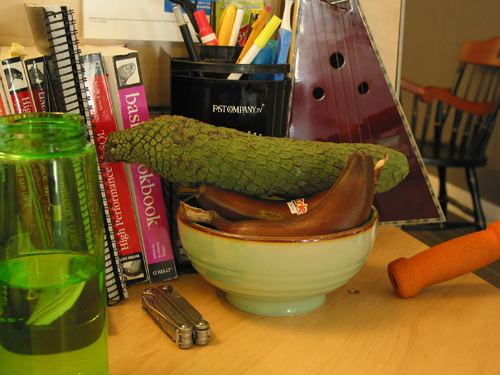
It looks like a dinosaur penis (if they in fact had them) and is not the easiest thing to clean. Tastes like a mix of banana and pineapple.
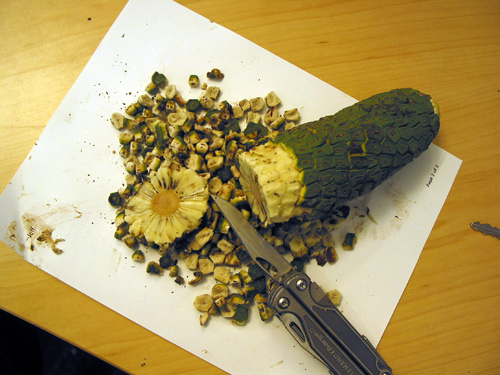
The House of Lamps or Lamp Lust
I firmly believe that expensive and well designed office chairs like Aeron or Mirra make a very good investment. On the other hand my friend, a very successful entrepreneur, tells me that much cheaper 300 dollar chairs are just as good, and that his most prized employees, when asked what kind of a chair they want said that it does not matter. My friend is very smart, very rich, and probably right.
People who have chair lust, like me, sometimes have an even more irrational desire – to buy expensive table lamps. When Joel Spolsky visited me at work, i pointed out to him that everyone at my office had a four hundred dollar Artemide Tolomeo desk lamp. Joel, famous for his office architecture fetish, was not impressed — oh yeah, we have a whole bunch of them too at Fog Creek, — he said.
I noticed that the set designer of the hit show House, MD also has an obsession with lamps. Even more interestingly, I noticed that Dr House’s office has three very interesting lamps.
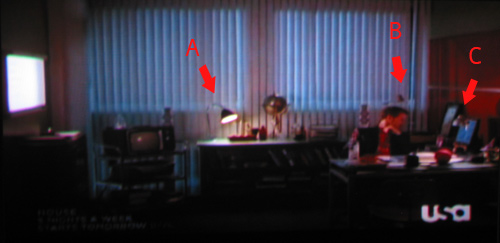
Lamp A is a paragon of British design, Bestlite, a lamp that I always wanted, and never bought because it’s crazy to spend that much money on a lamp. Designed by Robert Dudley Best and made famous by Winston Churchill, who had one in his office, it’s the Bentley of expensive designer lamps. It’s just crazy to spend over $600 on a lamp, innit?
Lamp B is the Artemide Tolomeo, a floor version of the lamp that I have at work. It’s a beautiful lamp that works very well. The desk version is about half the price of Bestlite, but it’s crazy to spend $300 on a lamp, right? Even if it’s designed by Michele De Lucchi and Giancarlo Fassina?
Lamp C appears all throughout Princeton-Plainsboro Teaching Hospital and gets the most screen time. It’s a 25 dollar Antifoni work lamp from Ikea, and the one that I have on my desk at home. Who designed it? I don’t know, it says “Ikea of Sweden”. What does Antifoni mean? According to Nordic Names, a website for translating crazy Ikea names like Bjöberg and Drömma, it means “antiphony“.
By the way, apparently Ikea founder Ingvar Kamprad has a Nazi past and chose to name all the furniture because SKUs were hard for him to keep track of due to his dyslexia. Also Gillis Lundgren, besides being famous for designing the Billy bookcase (I have 12 of these in my apartment) , actually invented the concept of flat pack furniture when he sawed off legs from a table that would not fit into a car.
Also on the subject of Ikea lamps:
Ostrich Egg
A new Whole Foods store opened right near my work. Whole Foods is an overpriced, somewhat organic supermarket, with a somewhat-premium selection. The problem with normal supermarkets is that they sell a mind-numbing variety of food that ranges from unhealthy to the point of poisonous, to very untasty at low, low prices. Whole Foods sells decent, and sometimes even healthy and delicious food, but at a budget breaking prices. They also sometimes have exotic products, and because of that provide me with material for Gastronomic Adventures.
Today on the menu: ostrich egg. It cost me $29, and apparently it was a pricing mistake – it now cost $39. Even though they are big, they are fricking expensive. Notice the “local” tag. Eating local food is all the rage these days thanks to The Omnivore’s Dilemma, and apparently there’s an ostrich farm somewhere in New York.
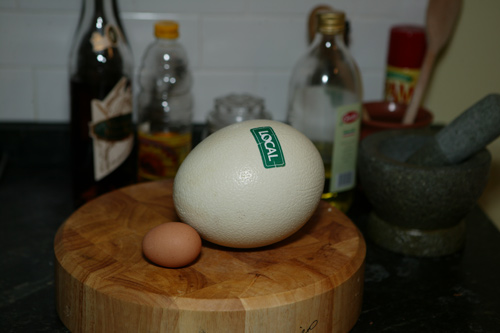
As tempting as the microwave experiment looked, and as high as the novelty value of the Scotch ostrich egg is, I decided on a more conventional recipe.
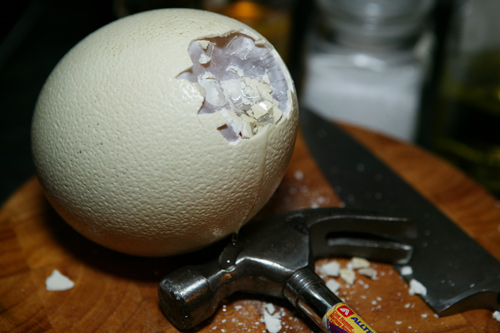
After taking a hammer to the egg, I fried some up and baked the rest.
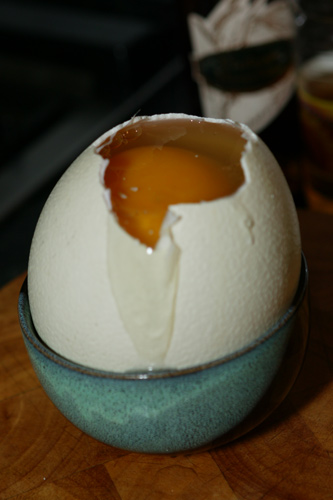
While the taste was similar to chicken eggs,
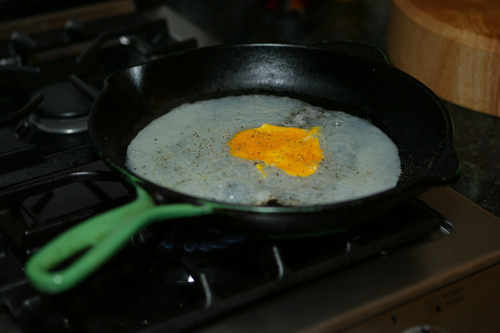
the texture was completely different. The fried egg white felt stringy, almost like noodles, and very, very tasty.
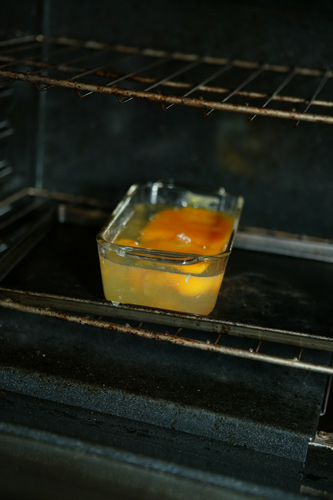
The baked yolk was creamy and without that sulfury taste that chicken egg yolks sometimes have. The whole thing was very tasty. If not for the price, I’d be eating ostrich eggs much more frequently.
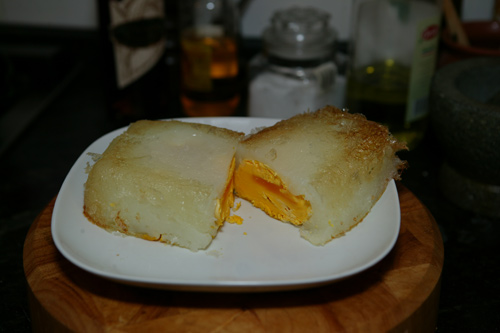
Deadprogrammer visits Odessa : Part I : Introduction
I live on a high floor of an art deco tower facing a busy Brooklyn street. The acoustics of the building and the street are such that I can sometimes hear what’s going on in the street right from my desk. Once I heard the sounds of a minor fender bender followed by an angry exchange unpleasantness that was escalating into some creative Russian profanity. The driver who rammed the other car was pretty unapologetic and criticized the driving skills of the one who got rammed. Then followed the exchange that made me laugh out loud – the driver who got rammed said – “the way you behave, man, you must be from Odessa.” “Yes, I am,” – answered the other guy, and added – “and you still drive like a moron.”
Odessa, Ukraine, my hometown, is a very special place. It has a Bizarro mirror twin, Odessa, Texas.
Odessa is a resort town situated on the shore of the Black Sea, right across from Turkey. Culturally it’s a bit like Brooklyn (or Brooklyn is a bit like Odessa because of an almost constant infusion of Odessans) – a city with an attitude, a city where a lot of famous people are born and famous people come to live. Architecturally it’s a lot like Vienna and St. Petersburg: a city built on a grand scale (but with softer edges), by the best architects.
Odessa’s ancient past is obscure: a Greek colony, a small town controlled by Kievan Rus, the Golden Horde, various Khanates and Kaganates, and finally a Turkish fortress. Odessa’s fortunes have turned when Russian forces invaded it in late 1700s. Catherine the Great apparently wanted to fortify the newly won land, and committed the people and resources needed to make the new city of Odessa a success.
The founding fathers of Odessa were a bunch of distinguished foreigners in the service of the Russian crown: General José Pascual Domingo de Ribas y Boyons, Armand Emmanuel Sophie Septemanie du Plessis, duc de Richelieu, and Count Louis Alexandre Andrault de Langéron.
Richelieu, or the Duc, as he’s commonly known in Odessa, will forever be loved by Odessans for his accomplishments. The way I imagine the Duc is sort of like the 18th century Steve Jobs, with a reality distortion field of his own, except without being an asshole (Richelieu was known for his kindness and indifference to money). Somehow – nobody know exactly how – Richelieu got Odessa the status of a “free port“. This meant that goods could be unloaded without paying the taxes within the city limit. This brought about an unprecedented influx of wealth, which in turn fueled the building of Odessa by the best European architects in the European manner. Odessa’s opera theater is only slightly smaller than Vienna’s, and is by the same architect.
Another unique aspect of this new city was the ethnic makeup. Besides the usual for Ukrainian cities mix of Ukrainians and Russians, Odessa became a melting pot. Frenchmen, Greeks, Turks, Germans, Armenians: all rushed into Odessa. Even the Jews were allowed in, and not being limited to certain occupations or living in a ghetto. Odessa is a very Jewish town despite what the author of Everything Is Illuminated might have you believe.
I left Odessa when I was 16. I came back for a 10 day visit 15 years later.
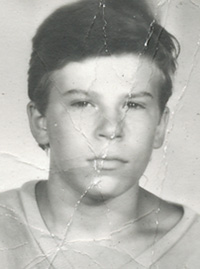
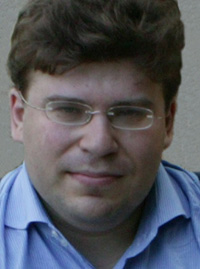
Odessa is a a city that makes you nostalgic, and I kept seeing it in my dreams. Luckily there’s a small international airport in Odessa and President Yushchenko kindly lets the holders of an American passport into the country freely, with no need for a visa.
12 hours and $1300 later I was standing in Odessa, looking for a cab. A pushy cabby was very surprised when I did not want to ride in his clean BMW and chose a cheaper and dearer to my heart filthy Soviet-vintage car.
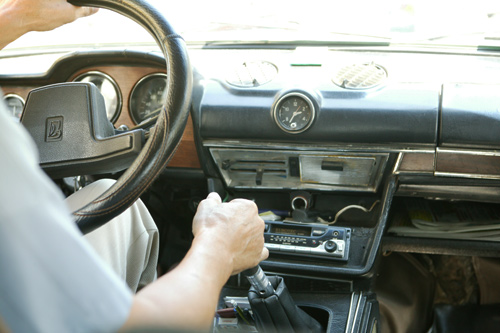
As far as hotels go, Ukraine is much more reasonable than Russia, but there are still no Marriott-like affordable and well-designed chains. There are overpriced hotels with decor that will burn your eyes out, cheaper, but scarier hotels, and apartments that you can rent which cover the gamut. Odessa has a population of about a million, but it swells to twice the size in the Summer season. Because of that there are thousands of very reasonably priced rental apartments with great amenities. Unfortunately I did not plan enough ahead, and ended up reserving a very cheap room in a brand new hotel Zirka that recently opened right in the center of the city.
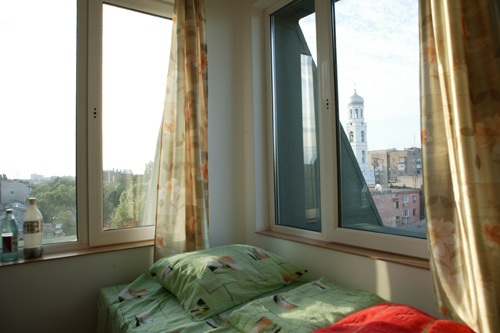
For a very reasonable $35/night I lived in a tiny-tiny, somewhat flimsily outfitted, but very clean room with a fully functioning shower, air conditioning and beautiful views, right in the historic center of Odessa.
The hotel was still being built when I lived there, and I herd later that it was becoming a bit notorious for renting the rooms at hourly rates.
As far as I’m concerned, you really can’t beat their amenities, their location, and their prices. Also, the staff was very courteous and professional. It was very quiet there during my stay – but worst case scenario – you might overhear noisy sex, from which you are not guaranteed at almost any hotel.
It’s hard to see on picture, but the towels had little dollar sign designs.
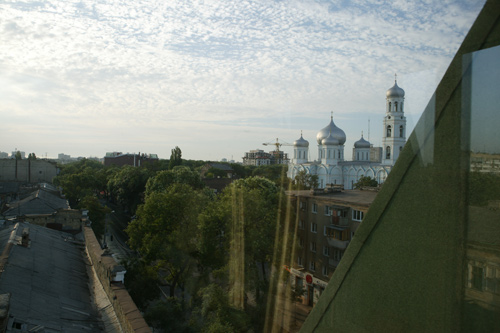
My hotel room reminded me very much of the affordable hotel room that I lived in in Japan, down to the picture of soft drinks that I took there.
In Odessa I mostly drank Borjomi, a Georgian mineral water. Borjomi, as far as I’m concerned is the tastiest mineral water in the world.
Odessa has its own mineral water, Kuyalnik, but it’s not sold in restaurants for some reason. I found a few bottles in a convenience store closer to the end of my stay. More about Kuyalnik later – I have a very special connection to it.
Apparently in Europe Diet Coke is marketed as Coca Cola Light, is sold in frosted bottles, and as far as I can tell, in a different formulation. It did taste different, and I know my cokes.
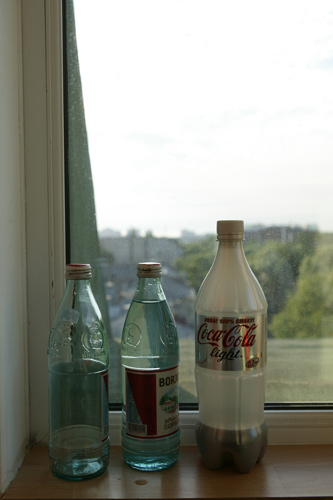
I quickly unpacked, grabbed my camera and went for a walk.
You really can’t enter the same river twice. I left Odessa when the Soviet Union was still intact. When I came back, a lot of things stayed the same.
There’s still a fountain in the City Square, the live band is still playing on Sundays and the pairs still dance.
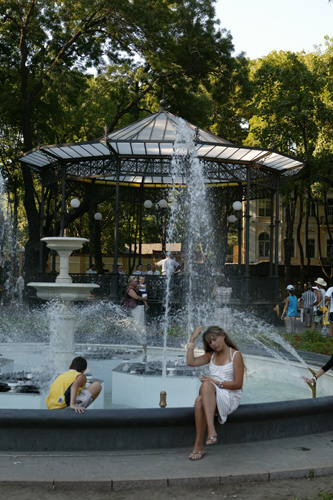
Acacia trees, the most common plant and the symbol of Odessa, are still filling the city with the aroma and sidewalks with their yellow flowers. Cleaning ladies (and men) still sweep the sidewalks with brooms made out of small branches. I brought a small jar with acacia blooms with me – the smell of nostalgia.
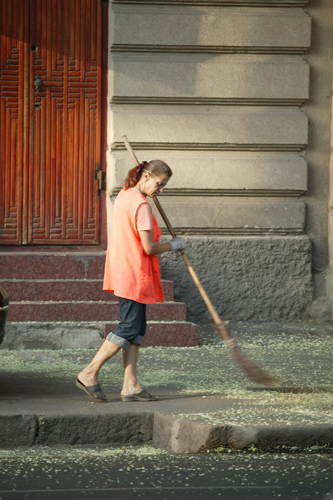
Remember that ethnic markup that I described earlier on? Well, somehow that mixing of genes resulted in the hottest women on the planet. Odessa is still the city of super hot women. This brings a large contingent of sex tourists and mail order (in this case – cash and carry) bride seekers. I was approached (probably because I was typing away on a laptop) by a most distressed gentlemen in a cafe: he could not get online. His hands were shaking. I fixed some gnarly windows crud setup options and wi-fi started working. All he cared about was getting to a dating site, and when it loaded, his hands finally stopped shaking.
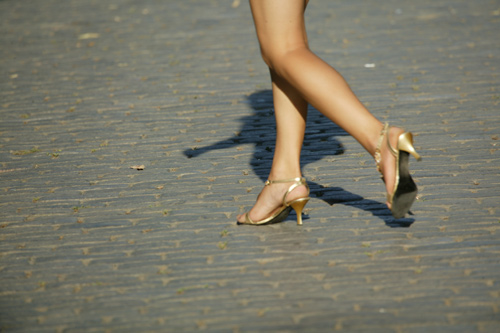
Things have changed though. Odessa took on some qualities of Havana, Cuba. Historic buildings are deteriorating, old cars are kept alive way past what’s reasonable.
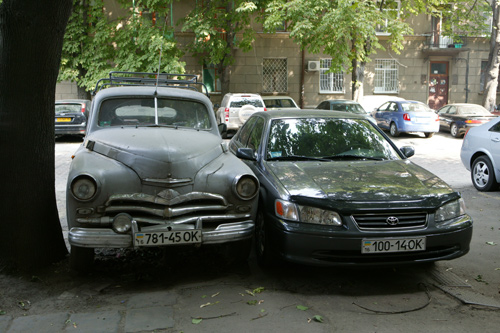
It’s not like Havana because people seem to prosper. Even the pensioners do not go hungry, there is a lot of new construction, and the rich are really, really rich. I’ve seen just about every expensive car I know in the streets, except maybe a Maybach.
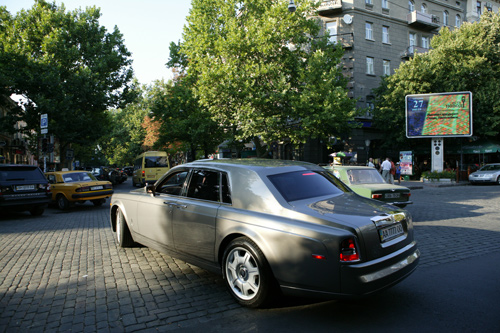
A few things about the new Ukrainian economy. The salaries are paid in US dollars, but dollars are not accepted anywhere. You can easily exchange them into hryvnas and back very easily, and the rate is somehow kept at about 5 to 1, without even having to shop around for a rate.
Real estate is amazingly expensive: for instance the apartment that my parents sold for something like $5K costs about $500K. At the same time the mortgage industry is almost non-existent.
I’m told that the government officials are amazingly corrupt, and they constitute a major portion of the upper crust. A police captain can easily become a multimillionaire, and so can just about any government bureaucrat. There’s a practice of “otkat” – kickback from a government project is rampant. High ranking policemen and bureaucrats are almost outside the law, like in India.
At the same time, even with all the corruption and bribery, the economy is pretty healthy, even without Russia’s oil.
Price-wise Odessa is not the bargain that it once was. For most things I’d estimate the cost of living at about 60-70% of Brooklyn prices. Food and rent is pretty cheap, but electronics, clothing and cars are more expensive. In particular, cars are taxed so much that they cost about 2 to 3 times more than in the US, which makes all those Rollses that I’ve seen even more impressive, and explain the Soviet-era cars.
Deadprogrammer Visits Odessa : Part II : Balconies and Yards.
Billion Dollar House
Exhibit A: Mukesh Ambani’s future billion dollar home:

Exhibit B: Bongo’s dream house by Matt Groening from “School is Hell“:
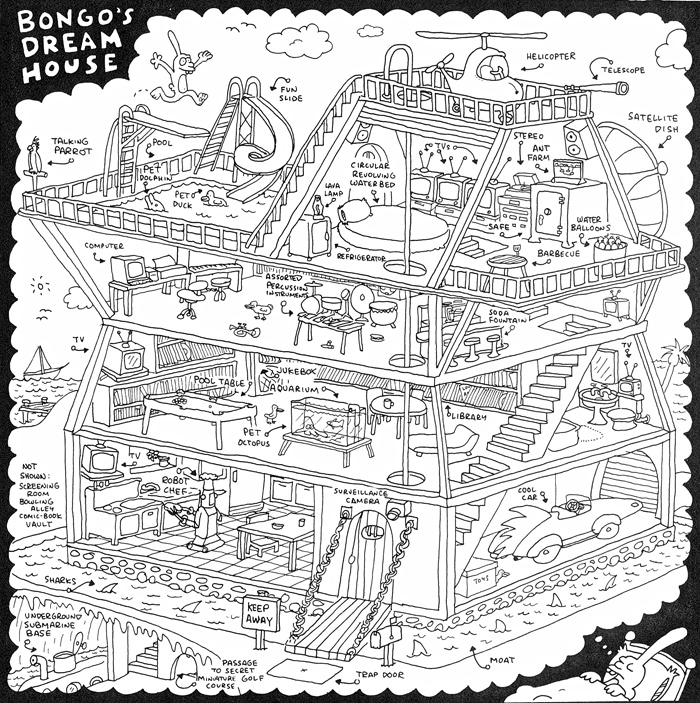
The Importance of a Good Chair
When the name Jason Calacanis comes up in conversation and he’s not within earshot, something unflattering is always said about him. Ah, that Calacanis. He’s blah and blah and blah. Not one thing he does is without controversy.
The reason his name comes up so frequently in conversations is because he’s absolutely brilliant. Take the post about how to save money running a startup for which he caught a metric ton of shit from the rest of the bloggerati. It is one of the best articles on the subject.
One piece of advice, “buy cheap tables and expensive chairs” ring especially true. Most IT professionals spend an average of 10 hours a day sitting down in a chair. Meanwhile, spending money on Aeron chairs is considered decadent. Decadent my ass.
At one of my previous employers good chairs were very hard to come by. The usual new-looking $100 chairs were extremely painful to sit on. I developed all kinds of weird leg and back pains for which forced me to see a doctor several times.
This is the most comfortable chair that I could find (and also the worst looking one). My boss had an Aeron for himself.
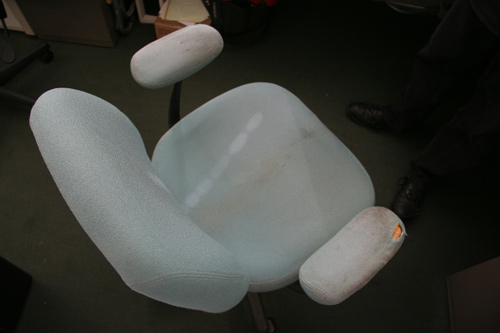
Bobby Fisher refused to play chess without a Herman Miller Time Life chair. By the way, the Time Life building for which lobby the chairs were supposedly designed does not have a single one in it, just a 100 dollar ass-wreckers for the security personnel and a Barcelona chairs in waiting lounges.
Not buying good chairs for programmers is pretty stupid. The place where I work now has outstanding chairs, and I am very grateful for that.
Japanese Books
Every time I am at a Kinokuniya bookstore, I deeply regret not being able to read Japanese.
Why does this book have two covers – with Hippie Bill and with Presidential Bill?
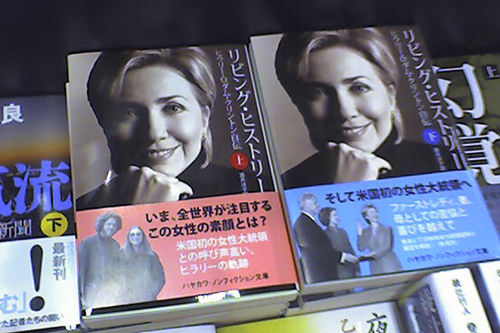
This book is amazing. I still regret not being able to part with $30 to get it, not only for the cover with the Twin Towers, but for the hand-drawn illustrations inside.
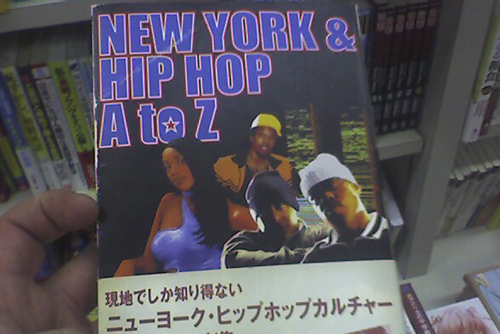
Lazyweb
Dear readers, I have a couple of things you could help me with..
1) Do you know a cheap and usable alternative to godaddy.com? A service with even cheaper domain prices (it’s $10/year for a domain) and a reasonable user interface?
2) I am still planning my switch to Mac – I am still using my Windows desktop and latptop at home and a Ubuntu desktop at work. Ubuntu is great for web dev, but at home I do need to connect to a lot of various peripherals that are basically unsupported in Ubuntu. Also, I like the pretty. Anyway, I am thinking of buying a G5 tower on eBay for about $1000. Hardware-wise it’s a dual processor machine similar to my dual Xeon Dell, but it was only $500 on eBay.. So, is this the best way of getting into Macing on the cheap? I don’t want to buy a Mac Mini because it cost an arm and a leg to add a second monitor.
3) I already mentioned this, but does anybody know a good Linux sysadmin with Apache/MySQL administration skills who’s looking for a job (preferably with some php coding skills)? Let me know, k?
What It’s All About?
I recently picked up “It’s Not About the Coffee: Leadership Principles from a Life at Starbucks”.
As you might know, I am a bit of coffee coin-a-sewer, owning a $2000 espresso machine and such. You might also remember the only popular blog post I’ve ever written – the one about the Starbucks logo. I was always very interested in everything Starbucks. The reason? Well, I really could not understand how a company with coffee that is so bad could be so popular. I mean, have you tasted the stuff?
“It’s Not About the Coffee” – wow, I thought, this should clear some things up. Because, I for sure know that it’s not about the coffee. I’ve had good coffee. It just can’t be about the coffee.
The first sentence of the book (int the A Note to Readers) reads: “Although this book is titled It’s Not About the Coffee, of course it is about the coffee–it’s about the people and the coffee.” Leadership lesson number one: start out with a lie, then weasel out.
Cloying, sacchariney corporate doublespeak only got worse on the following several pages, I am not even sure I can get through the book at all. There might be some interesting Starbucks anecdotes further down, so I’ll keep trying. Meanwhile I get a weird feeling about Howard Behar – the same I used to get about Soviet Politburo members: I could not understand if they believed themselves in the ideals that they extolled.
Ok, I read a couple of more pages, and was instantly rewarded by learning this interesting, although disturbing fact: besides the coffee passport, which I knew about, there’s a piece of corporate propaganda known as the “Green Apron Book.” Almost like Chairman Mao’s “Little Red Book”. Neat.
All of this reminded me a story that I’ve read somewhere about a North Korean student at a Moscow university that used to carry around with him a little portrait of the Great Leader, Kim Il-sung. He would meditate, looking at the picture for hours, and even used it instead of a mirror while shaving. When asked – how could he shave without a mirror, he said – this is better than a mirror.
I guess, if you can make people shave in front of a portrait, you can make them believe that Starbucks coffee is tasty. There are ways…